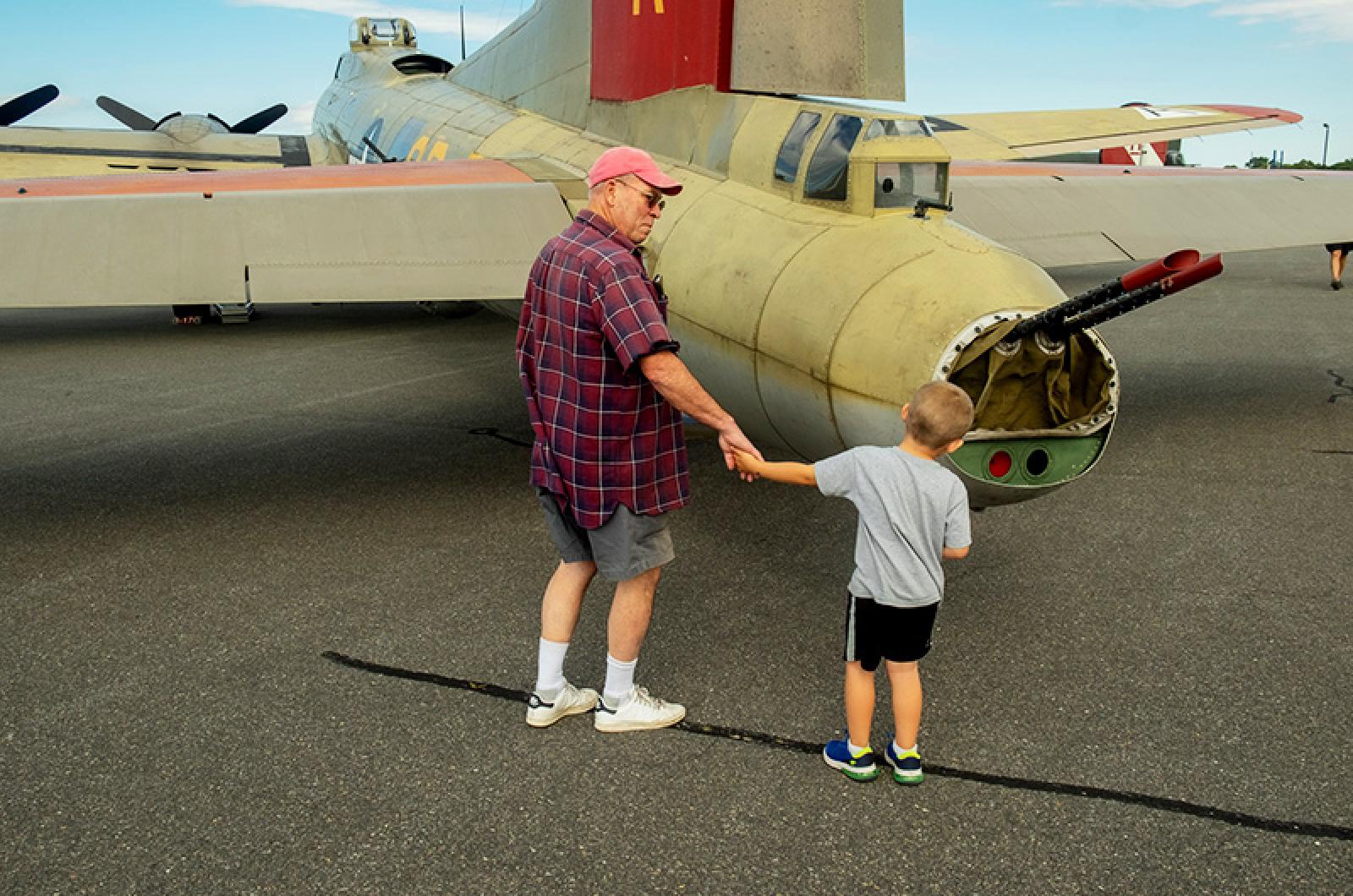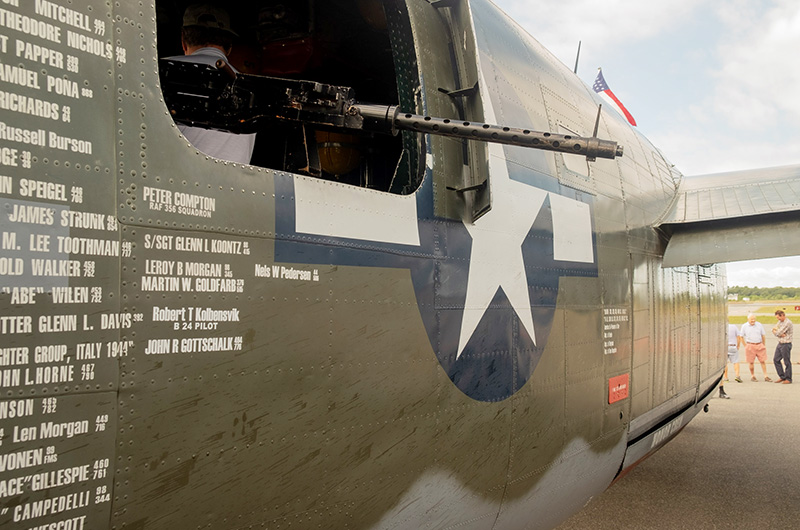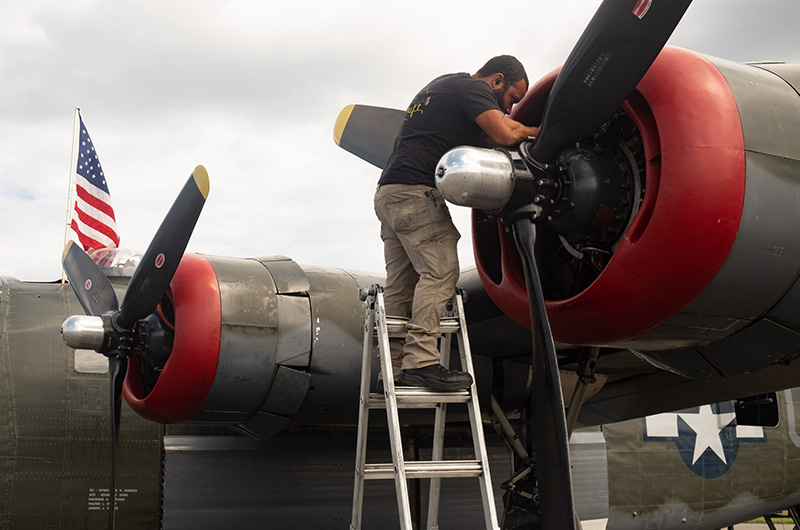Of the nearly 20,000 Consolidated B24 Liberator bombers built during and shortly after World War II, only 13 survive today. Of those 13, only eight reside in the United States. Only two of those eight are airworthy. And only one is actually flying.
That one was on Martha’s Vineyard this past Monday and Tuesday, available for viewing, tours and even flight lessons (at the price of $2,200) as part of the Collings Foundation traveling Wings of Freedom exhibition at the Martha’s Vineyard Airport. Along with the B24, the Stow-based foundation dedicated to preserving “living history” brought with them a fully-restored B17 Flying Fortress, B25 Mitchell and the P51 Mustang. The fleet represents one of the most historic and diversified traveling airshows in the country.
“It’s a field of dreams out there,” said flight engineer Gary Dean. “We make history come alive.”
Visitors to the airport this past week had the chance to walk through the historic aircraft, transporting themselves back to a time when young men, most under 21 years old, patrolled the skies with the weight of a world war at their feet and 100-pound bombs at their disposal. Visitors explored the planes’ narrow passageways, the seemingly infinite switchboard of dials, the frightfully-loose machine gun triggers and cramped quarters of its operators.
“We were driving by yesterday and just thought we would check it out,” said Stratford, Conn. native Christine Kudravy while walking through the B17. Although she works for a company that makes parts for Sikorski and is more of a helicopter person herself, she couldn’t help but get emotional as she looked out the gunner window on the plane’s back side.
“Thinking about the men who flew these, it almost makes me cry,” she said.
The fully-restored planes have an amazing history of their own. After the B24 saw combat in the Pacific theatre as a bomber and resistance supplier during World War II, the aircraft was abandoned by the Royal Air Force in a bomber graveyard in Khanpur, India. Eventually, the Indian air force restored the aircraft and sold it to Robert Collings, who started the Collings foundation, where its one million pieces were completely disassembled for a full restoration.
Thirty years later, it remains one of only two airworthy B24’s in existence — and the only one that still gets to fly next to its World War II partner, the B17 Flying Fortress. Together, the two planes served as the backbone for American bombing units during the war.
Veteran Pierce Kirby took in the grandeur of the foundation’s four-propeller B17, which had flown as part of the Air/Sea rescue squadron after World War II and then spent two decades fighting forest fires, dropping water instead of bombs. When he was in the armed forces, Mr. Kirby was stationed on boats, like the USS Goodrich and USS Edmonds, rather than in the air. That made him thankful looking at the B17 on Tuesday.
“I’m glad I wasn’t doing these,” he said while counting the bombing missions indicated by small, missile-shaped tallies on the plane’s left flank. They numbered 130. “My God, they must have sweated out those last ones,” he added.
The newest addition to the Collings’ Foundation fleet, a Mustang P51 known as ‘Toulouse Nuts,’ was up in the air on Tuesday for a ride, zipping overhead. Because all of the planes are operational, the foundation has a traveling mechanic, Angel Estrada, who performs 50-hour check-ups on all the aircraft to ensure they can continue to be experienced in the sky as well as on the ground. He was working on the B25 Mitchell’s left propeller on Tuesday. The B25 is known for its involvement in the Doolittle Raid on Tokyo during the war.
“I love it,” Mr. Estrada said. “One day down the road hopefully somebody will be taking care of our jets from today.”
Mr. Dean said some of the most meaningful moments from his work with the foundation have come in the air, bringing former World War II veterans back to their time as pilots. He described stories of many who could barely walk on the ground, but were able to explore the plane with deftness and agility once they were in the sky.
“These things just unlock people,” Mr. Dean said. “They’re a very powerful tool.”






Comments (2)
Comments
Comment policy »